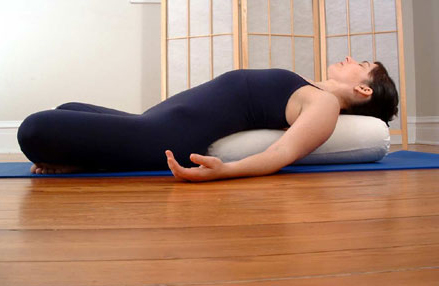Health > Keeping Fit > yoga > Yoga and breathing
Yoga and breathing

There is a saying in yoga: When you can control your breath, you can control everything.
People give you strange looks when you tell them you spent your Saturday afternoon breathing. But that’s what I did. There were about 10 of us at the workshop on breathing at my local yoga center. We were all there for different reasons: to learn how to use breathing to cope with stress, asthma, and respiratory illness; to discover how to breathe efficiently during yoga, meditation, our daily chores, walks in the neighborhood, and hikes up mountains.
We’re all born knowing how to breathe. Watch a baby breathe. See how she automatically fills up her entire abdomen and ribs like a little balloon? She doesn’t breathe only from the upper chest in short, rapid gasps. As we age, we develop inefficient breathing habits as the result of other habits such as smoking. Women have been conditioned throughout history to alter their breathing habits for the sake of appearance: The corset made deep breathing impossible. Today’s young woman is still trussed up in a “media corset” as she is bombarded from newsstands, videos, movie screens, and television shows with the message to “suck in your gut.”
Breathing is a healing tool, according to my yoga teacher, and it can be relearned with practice. How do we get back to the “breath of babes”?
First, we learned about the three types of breathing:
- Low or abdominal breathing — breathing with the diaphragm and abdominal muscles. When you breathe in, the abdomen extends (as if you were pregnant). When you breathe out, it deflates.
- Middle breathing — lower ribs expand forward and to the sides with each breath. To see if you breathe from the middle, place your fingers along your ribs and breath. Do your fingers move with each breath?
- High or upper chest breathing — short, rapid, shallow breaths originate from this area. This is where many smokers and corset wearers breathe.
To relearn deep breathing or the breath of babes, as I call it, we stretched out on the floor on our backs. (Practicing breathing sitting up is more difficult.) Nearly all of us used pillows under our heads. Some of us also used pillows under the back and knees. The idea is to get comfortable. Then we placed one hand on the abdomen and one hand on the lower rib and practiced filling up those areas with breath. Keep the mouth closed and breathe through the nose.
The first thing you realize is that it’s been a long time since you tried to control those muscles and you growl at your teacher who is showing off by inflating one lung and then the other at will (a trick that looks like it belongs in the circus). Focus on the image of a balloon inflating from your abdomen and into your ribs or a wave of air filling you from abdomen up through the ribs and into the chest. It becomes all about controlling the breath: inhale — hold — exhale. Our teacher suggested that we count as we inhale (10 counts), hold for 5–10 counts, and exhale slowly (another 10 counts). If you can’t do a count of 10-10-10, do 7-7-7 or 5-5-5. It may take practice to get to 10-10-10 or 20-20-20.
Destressing is not just a bunch of hot air or is it
The ultimate destressing comes with slowing the breath to 1 to 2 breaths per minute, my teacher says. He suggests doing three to five of those extremely slow breaths when you really need to relax and you will feel like a new person. However, on this Saturday afternoon, I can’t even come close to that new person in me. You must practice the skills at night, my teacher says, and then use them during the day. He recommends posting notes throughout the house, near the telephone, on the computer monitor to remind yourself to breathe deeply.
The telephone can be a big stressor, so he advises more advanced methods of destressing. “Don’t answer the phone on the first ring,” he says.
“Impossible,” says a mother of three teenagers. “It’s a stampede.”
Still, he maintains, let it ring, empty your lungs, take a slow deep breath, start to exhale, and then answer.
We all have events that trigger stress or anxiety — answering the telephone, approaching green lights (will it turn yellow just as I get there?), serving during a tennis match, making the big presentation, meeting new people. You may find yourself unconsciously holding your breath during those moments. Feeling breathless or holding your breath is a cue to use deep breathing.
When do you use deep breathing?
Don’t use deep breathing during meditation. That is the time when you want to be aware of your breath, but not necessarily controlling it. Use deep breathing at times when you need energy or want to fill calm: during yoga, during exercise (instead of panting on the treadmill and using only your chest to breathe, deepen and slow the breath), before stressful confrontations, before doing something you don’t like to do, before meditation (a warm-up that calms the mind). Or do deep breathing just for the fun of it, just to feel calm and at peace.
Focusing on breathing concentrates the mind. The great Paramahansa Yogananda compared breathing and restless thoughts to storms. We can’t find serenity — that no stress state — until we calm those storms through deep breathing and meditation.
Pranayama - 'Pranayama' is the fourth stage in Pathanjali's eight stage Yoga discipline..... ....
|

